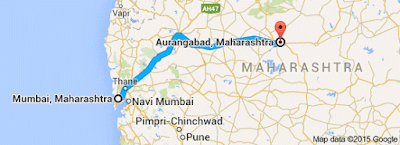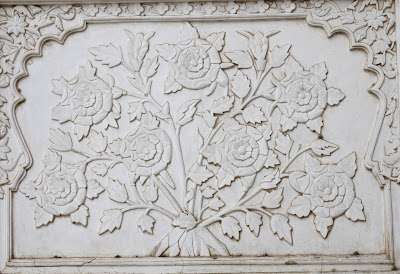I have this habit of planning quick road trips at every opportunity that I get and the 17th Sept weekend was one such opportunity. We took a day's leave on 18th Sep'15.
We left Kandivali Lokhandwala at 6:30 hrs and quickly headed towards the Nashik - Aurangabad route.
I had booked Oyo rooms for the 1st time at Aurangabad.
The plan, am sure is evident...just to clarify, we had decided to cover Ajanta & Ellora apart from Aurangabad.
So off we headed and made a quick stop just before Igatpuri to grab a quick breakfast that we were carrying and have a brew of Davidoff...the first time we were carrying a Thermos flask with hot water and coffee separately. Boy! Was it fun!
It being the end of Monsoon, the weather was foggy in these parts and light streaming through the clouds made it dreamy...
Off we headed, driving through the Nashik - Sinnar route to reach Aurangabad around 3:00 pm.
It was the day of Ganesh Chaturthi and the roads at Nashik were crowded...but after a little effort we managed to snake out stopping for a quick lunch just before Aurangabad.
We checked into the Hotel at Aurangabad into an Oyo room and after a little lazing around and a cup of coffee, decided to complete the places within Aurangabad.
We headed towards the most important monument at Aurangabad - Bibi ka Maqbara (Bibi's tomb). Although we knew it was a replica of the Taj Mahal, the similarity still amazed us. We reached around 5:30 in the evening and it was still day light.
We stared at the monument for a while and then walked towards it, clicking shots from different angles. One of my favourites is down below -
The view of the front of the monument
We left Kandivali Lokhandwala at 6:30 hrs and quickly headed towards the Nashik - Aurangabad route.
I had booked Oyo rooms for the 1st time at Aurangabad.
The plan, am sure is evident...just to clarify, we had decided to cover Ajanta & Ellora apart from Aurangabad.
So off we headed and made a quick stop just before Igatpuri to grab a quick breakfast that we were carrying and have a brew of Davidoff...the first time we were carrying a Thermos flask with hot water and coffee separately. Boy! Was it fun!
It being the end of Monsoon, the weather was foggy in these parts and light streaming through the clouds made it dreamy...
Off we headed, driving through the Nashik - Sinnar route to reach Aurangabad around 3:00 pm.
It was the day of Ganesh Chaturthi and the roads at Nashik were crowded...but after a little effort we managed to snake out stopping for a quick lunch just before Aurangabad.
We checked into the Hotel at Aurangabad into an Oyo room and after a little lazing around and a cup of coffee, decided to complete the places within Aurangabad.
We headed towards the most important monument at Aurangabad - Bibi ka Maqbara (Bibi's tomb). Although we knew it was a replica of the Taj Mahal, the similarity still amazed us. We reached around 5:30 in the evening and it was still day light.
As we kept meandering around the monument, I kept looking at the people around me and their expressions. People talking about it being the "Poor man's Taj Mahal", some talking about it as a tribute by Aurangzeb to his wife trying to imitate Shah Jahan.
The actual fact is that it was built by Azam Shah - Aurangazeb's son in memory of his mother - Dilras Banu Begum.
It is said that Aurangzeb was an extremely austere king. He believed in using the people's money for the welfare of the state, rather than for his own personal desires or that of his kin.
His austerity led him to carry out many atrocities on the people and he abhorred the fact that his father spent lavishly on building monuments and epithets for personal pleasure.
Aurangzeb is also known to have earned his own bread and butter by writing miniatures of the Quran in calligraphic Arabic and making skull caps and selling them.
It is due to this austerity, that the Bibi ka Maqbara turned out to be a poor replica of The Taj as the budget sanctioned was only 7 lakhs during that period and they had to cut down the use of marble and use limestone instead on the minarets.
There was something very tranquil about this place and as dusk settled in, we decided to just sit it out for a while at this place. There was a slight drizzle and while we took shelter to protect our equipment, we kept looking at the monument to see it in the changing evening colours. It wasn't very fruitful, because coloured lighting from the entrance of the monument was not helpful in any way - neither was it lighting up the monument nor was it giving enough light to capture a good picture.
After a lot of trial and error, this was the best we could come up with.
A couple of images of the work visible on the monument-
After spending about 3 hrs at this place, we headed back to the Hotel, eagerly awaiting the next day as we had planned The Ajanta caves.
Little did we know.....a new unimaginable adventure awaited us!















